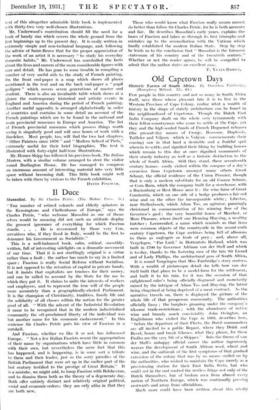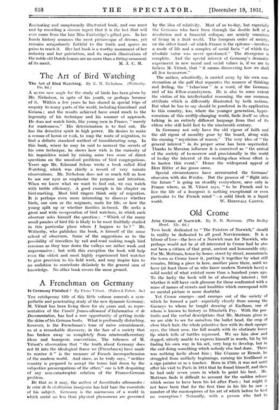Old Capetown Days
FEW people in this country and not so many in South Africa itself, save those whose pleasant fate it is to live in the Western Province of Cape Colony, realize what a wealth of history in the shape of stately architecture can be found in the neighbourhood of Capetown. Though the Dutch East India Company dealt on the whole very tyrannously with their fellow-countrymen who came to settle at the Cape, yet they and the high-souled bands of French Huguenot refugees (the present-day names of Cronje, Rossouw, Duplessis, Taillefer and Viljoen—which is Valjean—commemorate their coming) saw in that land a desirable and a fruitful spot wherein to settle, and signified their liking by building houses which remain to this day at once dignified monuments of their sturdy industry as well as a historic distinction to the whole of South Africa. Still they stand, these seventeenth century houses—easily visited within the compass of a day's excursion from Capetown —amongst many others Groot Schuur, the official residence of the Union Premier, though that is only a modern substitute for an old Cooren Schuur, or Corn Barn, which the company built for a storehouse, with a Rustenburg or Rest House near it ; the winc-farm of Great Constantia, which on one side of a hedge produces a fair red wine and on the other the incomparable white ; Libertas, near Stellenbosch, which Adam 'PDS, an agitator, punningly christened in conunemoration of his winning free of the Governor's gaol ; the very beautiful house of Meerlust, or More Pleasure, where dwelt one Henning Huysing, a wealthy butcher ; Leeuwenhof, a name which reminds us that lions were common objects of the countryside in the seventmoth century Capetown, the Cape archives being full of allusions to them as roofvogels or birds of prey ; and, above all, Vergelegen, "Far Laid," in Hottentots Holland, which was built in 1700 by Governor Adriaan van der Steil and which is to-day, thanks to the fostering care of the late Sir Lionel and of Lady Phillips, the architectural gem of South Africa.
It is round Vergelegen that Miss Fairbridge's story centres. With a wealth of picturesque detail she tells how van der Steil built that place to be a model-farm for the settlement, and built it to his ruin, for it was the occasion of that enlightened ruler's being officially disgraced and monetarily ruined by the intrigue of Adam Tas and Huysing, the latter being chagrined at being deprived of a meat contract. As time narrative travels on, there is displayed the picture of the whole life of that prosperous community. The authorities officially fussy ; the burghers groaning under time company's irksome trade-restrictions ; with the abundance of native wine and brandy much conviviality -.John Ovington, an Englishman who visited the Cape in 1093, describes how, " before the departure of their Fleets, the Dutch commanders are all invited to a public Repast. where they Drink and Revel, bouze and break Glasses, what they please, for these Frolics are the very life of a Skipper." Into the theme of van der Stell's unhappy official career the author ingeniously weaves the development of South African wool, wheat and wine, and the outbreak of the first symptoms of that gradual extension of the colony that was by no means smiled on by the authorities, who wished to maintain time Cape merely as a provisioning station for their East India fleets, but who could not in the end control the restless fringe not only of the Dutch themselves, but of broken men from almost every nation of Northern Europe, which was continually pressing eastwards and away from officialdom.
Much more could have been written about this wh■dly fascinating and sumptuously illustrated book, and one must end by recording a sincere regret that it is the last that will ever come from the late Miss Fairbridge's gifted pen. In her hands history assumes the most picturesque of dresses, yet remains scrupulously faithful to the truth and spares no pains to reach it. Her last book is a worthy monument of her industry and her patriotism, and its superb illustrations of the noble old Dutch houses are no more than a fitting ornament



































 Previous page
Previous page